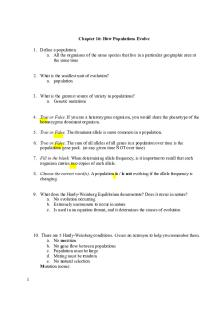Review Session #1 - Chapter 16: How Populations Evolve PDF

| Title | Review Session #1 - Chapter 16: How Populations Evolve |
|---|---|
| Course | (Uc) General Biology Ii |
| Institution | Quinnipiac University |
| Pages | 3 |
| File Size | 132.7 KB |
| File Type | |
| Total Downloads | 47 |
| Total Views | 144 |
Summary
Chapter 16: How Populations Evolve...
Description
Chapter 16: How Populations Evolve 1. Define a population. a. All the organisms of the same species that live in a particular geographic area at the same time
2. What is the smallest unit of evolution? a. population
3. What is the greatest source of variety in populations? a. Genetic mutations
4. True or False. If you are a heterozygous organism, you would share the phenotype of the homozygous dominant organism. 5. True or False. The dominant allele is more common in a population. 6. True or False. The sum of all alleles of all genes in a population over time is the populations gene pool. (at any given time NOT over time) 7. Fill in the blank. When determining allele frequency, is it important to recall that each organism carries two copies of each allele. 8. Choose the correct word(s). A population is / is not evolving if the allele frequency is changing.
9. What does the Hardy-Weinberg Equilibrium demonstrate? Does it occur in nature? a. No evolution occurring b. Extremely uncommon to occur in nature c. Is used in an equation format, and it determines the causes of evolution
10. There are 5 Hardy-Weinberg conditions. Create an acronym to help you remember them. a. No mutation b. No gene flow between populations c. Population must be large d. Mating must be random e. No natural selection Mutation (none) 1
Gene flow (none) Large population Random mating Natural selection (none)
11. True or False. Mutations are a result of changes in the environment. (mutations are random)
12. True or False. Gene flow can only occur if organisms move between populations. Ex. In plants pollen moves but the organisms do not immigrate or emigrate Organisms don’t need to be moving for genes to be flowing
13. Is genetic drift affected by population size? Explain. a. Yes i. Minor impact in large population ii. Major impact in small population
14. What is the difference between bottleneck and founder effect? a. Bottleneck – the overall population decreases (due to catastrophe) b. Founder effect – a population is started by a small group that is isolated from other individuals (allele frequencies change when small group leaves)
15. True or False. Mating within a population is almost never random.
16. True or False. All genotypes are equal. Some genotypes are more favorable for current environment
17. What does abiotic vs biotic mean? Provide an example. a. Abiotic – nonliving (ex. Rocks and water) b. Biotic – living (ex. Animals and trees)
18. What resources are the main sources of competition? What type of organisms is this between? a. Food, water, mates (sexually reproducing organisms) b. Between the same and/or different species
19. What type of organisms does coevolution occur between? 2
a. Between predator and prey b. If the prey evolves a way to avoid predator, the predator can evolve to overcome that avoidance
20. True or False. Male to male competition and structures that increase attractiveness to females are not always beneficial for survival. During fights males can get injured or die (not beneficial for survival)
21. Label the following selection graphs. (Note: shift from red to blue)
Disruptive selection
Stabilizing selection
Directional selection
22. What is it called when environmental factors favor heterozygotes? Give an example of this. a. Balanced polymorphism i. Sickle cell & malaria in Africa 1. Heterozygous individuals have much lower chance of getting malaria 2. Homozygous recessive have sickle cell anemia (can be deadly) and homozygous dominant have a much higher risk of getting malaria
3...
Similar Free PDFs

Wardrop Review Session-Exam 1
- 11 Pages

Review chapter 16-17
- 7 Pages

ANT Exam 1 Review session
- 5 Pages

Exam 2 Review Session
- 5 Pages

Review Session for Exam
- 4 Pages

CS61B CSM review session
- 16 Pages

Chapter 16 Notes - How Genes Work
- 10 Pages

MAT270 Final Review Session
- 5 Pages

Session 1
- 7 Pages

BU111 SI Midterm Review Session
- 8 Pages
Popular Institutions
- Tinajero National High School - Annex
- Politeknik Caltex Riau
- Yokohama City University
- SGT University
- University of Al-Qadisiyah
- Divine Word College of Vigan
- Techniek College Rotterdam
- Universidade de Santiago
- Universiti Teknologi MARA Cawangan Johor Kampus Pasir Gudang
- Poltekkes Kemenkes Yogyakarta
- Baguio City National High School
- Colegio san marcos
- preparatoria uno
- Centro de Bachillerato Tecnológico Industrial y de Servicios No. 107
- Dalian Maritime University
- Quang Trung Secondary School
- Colegio Tecnológico en Informática
- Corporación Regional de Educación Superior
- Grupo CEDVA
- Dar Al Uloom University
- Centro de Estudios Preuniversitarios de la Universidad Nacional de Ingeniería
- 上智大学
- Aakash International School, Nuna Majara
- San Felipe Neri Catholic School
- Kang Chiao International School - New Taipei City
- Misamis Occidental National High School
- Institución Educativa Escuela Normal Juan Ladrilleros
- Kolehiyo ng Pantukan
- Batanes State College
- Instituto Continental
- Sekolah Menengah Kejuruan Kesehatan Kaltara (Tarakan)
- Colegio de La Inmaculada Concepcion - Cebu





